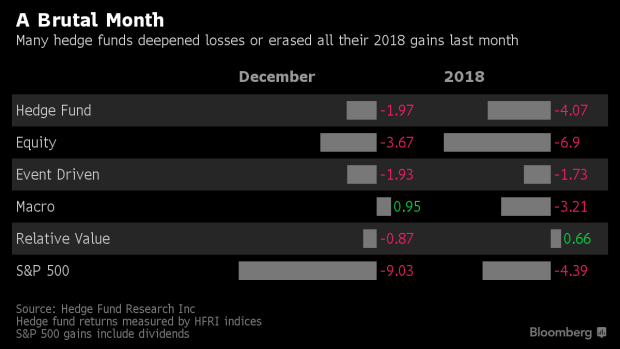Jan 11, 2019
‘Extraordinary’ Month Heaps Further Pain on Hedge Funds
, Bloomberg News

(Bloomberg) -- A spurt in volatility was supposed to help hedge funds rebound from years of mediocre returns. Instead, it made things worse.
Stock markets’ fear gauge, the Cboe Volatility Index, surged last month as the S&P 500 suffered its worst monthly decline in nearly a decade. Hedge funds, which had gotten used to rising asset values after years of easy money policy by central banks, slumped further and ended the year down 4 percent, their biggest decline since 2011.
This double blow raises the prospects of further capital outflows and undermines the $3 trillion industry that is expected to make money through long/short bets designed to profit from large market movements during volatile periods. Already burned by a similar spike in volatility last February, investors pulled roughly $15 billion from hedge funds last year through November, according to data from eVestment.
Few strategies were spared in the latest slump. Lansdowne Partners LP’s $7 billion main fund, David Einhorn’s flagship money pool and Horseman European Select extended losses. Key Square’s $5 billion macro fund, started by former chief investment officer at Soros Fund Management, Scott Bessent, erased all its gains.
“I can’t remember many Decembers where being flat could be argued a success, but this was an extraordinary month," Greg Coffey, founder of Kirkoswald Capital Partners LLP, wrote in a letter to investors. His fund lost 0.1 percent in December to end the year up 5.4 percent.
Hedge funds are not fully immune to market chaos, but many of them lost more than the broader market as political risk, rising concerns on economic growth, prospects of trade war and the combative stance of President Donald Trump posed a challenge.
The Lansdowne Developed Markets fund posted a loss of 7.4 percent last year, while Horseman European Select sank 10 percent in December to erase a third of its value in 2018. Greenlight Capital closed out 2018 with its biggest annual loss ever in the main fund. Key Square’s macro hedge fund lost 3.1 percent to end the year down 2 percent. Spokesmen for Lansdowne Partners and Key Square declined to comment, while a spokeswoman for Horseman confirmed the return.
There were some notable exceptions, such as Crispin Odey, whose bearish bets fueled a 53 percent surge in his hedge fund and Brevan Howard, which returned 12.3 percent in its main hedge fund for best year since the end of the global financial crisis.
But for most, especially those with high net exposure to markets, it was a year to forget. More than half the hedge funds tracked by Preqin moved into a tough December with losses, the worst year since 2008 when three quarters of them suffered declines.
“December proved, if proof was needed, that most liquid hedge funds tend to behave like the market," said Nicolas Roth, head of alternative assets at Geneva-based Reyl & Cie. “Hedge funds providing access to complex and less liquid markets are the way forward to shield portfolios from market gyrations."
Source: Bloomberg reporting
--With assistance from Suzy Waite, Melissa Karsh and Saijel Kishan.
To contact the reporter on this story: Nishant Kumar in London at nkumar173@bloomberg.net
To contact the editors responsible for this story: Sree Vidya Bhaktavatsalam at sbhaktavatsa@bloomberg.net, Marion Dakers, Patrick Henry
©2019 Bloomberg L.P.